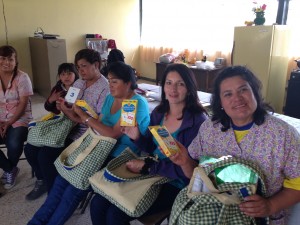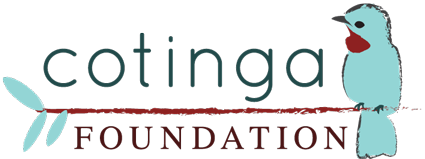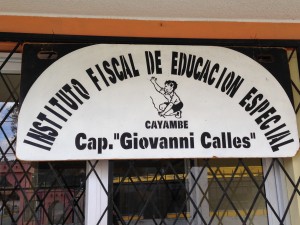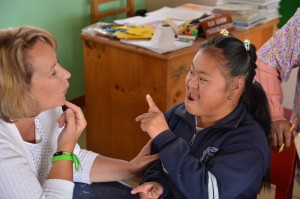Our Story
In June of 2011, my husband and I, plus 6 other people from our church went on a mission trip to Cayambe, Ecuador. My cousins, David and Brenda Meyer, have been missionaries there for many years and invited us to come on the trip to help rebuild the church and community center. We had excellent timing because on our first day the town was holding a Rose Parade. One of the groups in particular caught my eye; it was from Instituto Fiscal de Educacion Especial, a special education school there in Cayambe. As a special education teacher, I wanted to know more about those kids and I asked the missionaries about them, but they didn’t know anything about the school.
In the spring of 2014, as we were preparing to go to Ecuador for the third time, I again thought about the special needs children I had seen on my first trip, and wondered if there was anything that I could do to help. I asked David Meyer to find out if I could visit the school one day while I was there. He went to the school and spent some time with the Director. After a couple of visits, the Director invited me to come and spend a week in their school. He was open to me working with the students and working with the teachers.
Just about 12 weeks later, I traveled to Cayambe by myself, a week ahead of the team from our church. The teachers were hesitant to talk to me at first, but quickly became interested as they told me about problems in their classrooms, and I responded with solutions from my own classroom experience and education. I found that they have a passion for their students but unfortunately very little training and almost no resources.
The main question on the first day was whether I thought their students could learn. The answer was a resounding ‘yes’. Their kids have great abilities. They are very open to ideas and learning. In the last twenty years, no one has ever come to help the teachers or students, and a little training went a long way to help them. For example, one little boy was only able to scribble, but using a magnifying glass was able to write his name perfectly.One little girl didn’t speak, but I was able to get her to imitate every word that I said using some simple speech therapy techniques.
The school invited the parents to a meeting one afternoon. Over 80 parents came. They all wanted to know if I thought their students could learn – the same question the teachers had. I talked to them about teaching their child throughout each part of their lives: counting potatoes while cooking, teaching them words while they are shopping, showing them money, etc. They stood in line an hour and a half after the meeting to ask more questions. The teachers and parents were eager to help their students but just needed some ideas of what to do, which no one had ever shared with them before.
 I was able to take with me some simple resources which were of great help to the teachers because the government does not pay for anything beyond the special education teacher salaries in Ecuador. The school did not have any books at all! I took weighted vests which can assist special education students on focusing in the classroom, as well a Spanish curriculum and other basic supplies.
I was able to take with me some simple resources which were of great help to the teachers because the government does not pay for anything beyond the special education teacher salaries in Ecuador. The school did not have any books at all! I took weighted vests which can assist special education students on focusing in the classroom, as well a Spanish curriculum and other basic supplies.
I also had a quilted bag full of supplies for each teacher. They were so excited to brainstorm ways to use each item in the bag. We talked about teaching words to the kids by labeling everything, how to teach them how to write a sentence, how to teach math using cards or dice or calculators, how to use index cards and dry erase boards. All of these items seem simple and basic in the US but the teachers there would not have them if I had not brought them.
With only me, for one week, with a few supplies I was able to make a huge difference in the lives of the special education students at that school in Ecuador. Since returning from that trip God has put a passion in my heart to continue to help these students and more like them in South America. The quality of life of so many people can be dramatically improved with a little training! This is why I have started the Cotinga Foundation.


